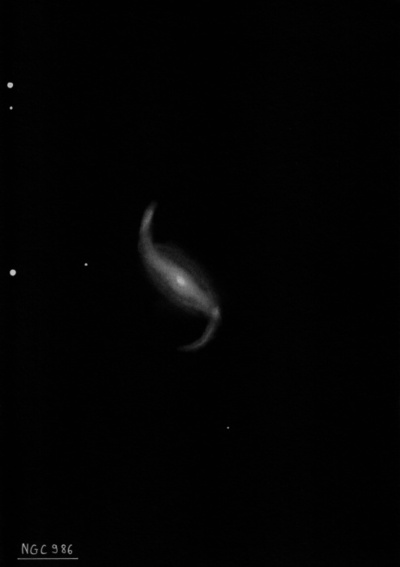
James Dunlop discovered NGC 986 = D 519 = h2487 on 5 Aug 1826 with his 9" reflector at Parramatta (near Sydney) and described "a faint nebula, of an irregular round figure, about 30" diameter, north of a bright small star." His position is 9' SE of NGC 986 (typical error) and there are no other nearby brighter galaxies that he might have been picked up instead.
John Herschel described the galaxy on 23 Oct 1835 as "pB, L, psbM, 3' long 2' broad, either binuclear or more elongated on the n.f. side than on the opposite." On a later sweep he logged "B, L, pmE, very suddenly much brighter middle, 100" long 60" broad, unequally bright, and exhibiting an approach to binuclear form." See Plate VI, figure 14 of the CGH Observations. Herschel's secondary nucleus appears to be the brighter southwest end of the central bar.
Joseph Turner sketched the galaxy on 29 Nov 1875 with the 48" Great Melbourne Telescope. He resolved it as a stretched S-shaped barred spiral. See Plate I, figure 8 "Observations of Southern Nebulae made with the Great Melbourne Telescope 1869 - 1885". Albert Le Sueur earlier made a sketch (plate VII, figure 80) that was not published.
200/250mm - 8" (1/1/84): fairly faint, fairly small, elongated SW-NE, bright core, diffuse edges.
400/500mm - 17.5" (12/28/94): fairly bright, moderately large, elongated 2:1 WSW-ENE, 2.5'x1.2'. Dominated by a 20" rounder core. A nice evenly matched mag 10.5 pair at 12" separation is 9' NNE with another similar star 1' S. Located 8' due north of mag 9 SAO 193771.
600/800mm - 30" (11/4/10 - Coonabarabran): at 264x, this beautiful, barred S-shaped spiral appeared very bright, large, with a very bright elongated central region that increased to a small, very bright core and bright stellar nucleus. Within the central region it was brighter along the central axis (bar) oriented SW to NE. At the southwest end of the central bar a relatively thin arm emerged and swept ~1.3' SE (clockwise). From the NE end of the central region another thin arm shot north for 1.5' and contained a very small, brighter knot or HII region.
Notes by Steve Gottlieb